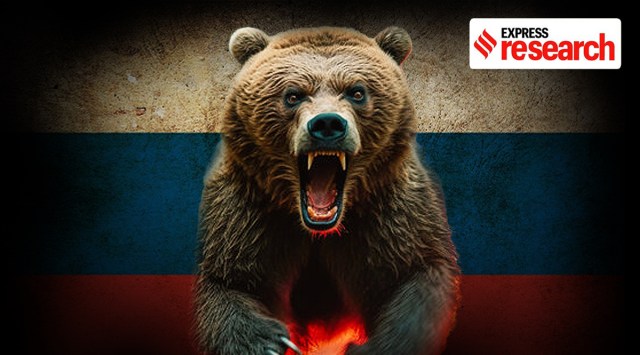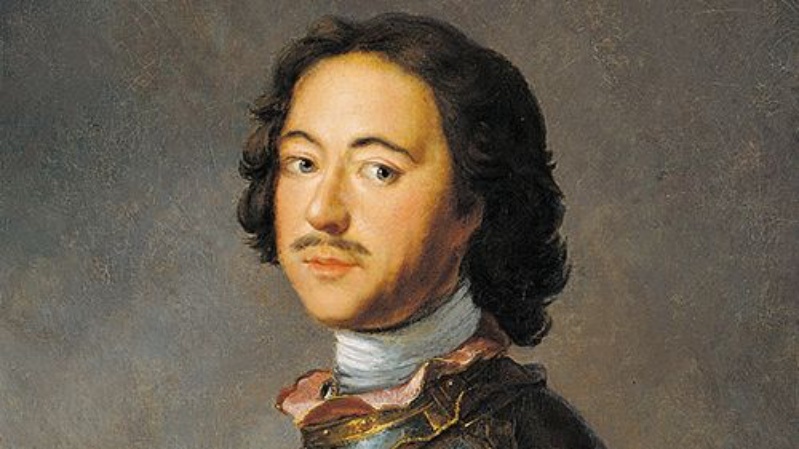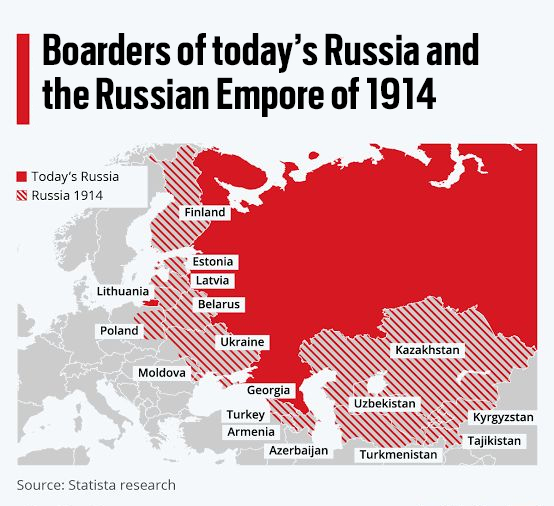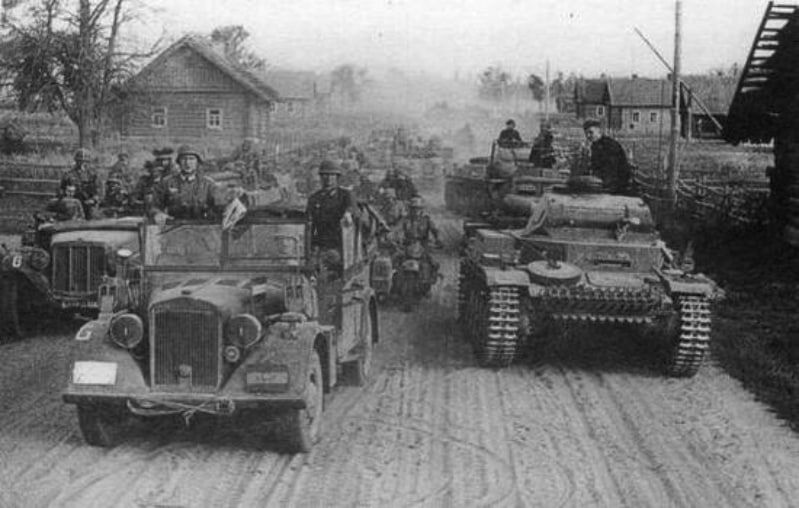How Russia’s imagination of its history shapes its present
The symbol for the immense county of Russia, and, one that its President is often seen embracing, is the mighty brown bear. Like its animal counterpart, Russia has spent periods in international hibernation but even when it is seemingly out of view, its ferocity lingers, a reminder to all that if provoked, the bear will fight back.
 The conceptualisation of Ukraine as Little Russia has played into long standing Kremlin propoganda alleging that Ukraine is a part of the Russian state.
The conceptualisation of Ukraine as Little Russia has played into long standing Kremlin propoganda alleging that Ukraine is a part of the Russian state. A Russia weakened by the Cold War is a Russia that longs for the glory of its past. Particularly prominent in that conceptualisation of the past is the 19th century theory of the Russkiy Mir or Russian World, predicated on the belief that there is a tripartite Russian identity of Greater Russia (Russia), Little Russia (Ukraine), and White Russia (Belarus.)
As Brooking fellow Fiona Hill writes in an article for Foreign Affairs Magazine, Russian President Vladimir Putin ordered invasion of Ukraine because “he believes that it is Russia’s divine right to rule Ukraine, to wipe out the country’s national identity, and to integrate its people into a Greater Russia.”
The history
As a concept, the idea of Russia dates back to the ninth century when a federation of Slavic tribes known as the Kievian Rus’ was established in what is now modern-day Ukraine. Facing constant barrages from Mongol forces, the fledgling Russia state relocated in the 13th century to Moscow.
Initially, Russia was nearly indefensible, a flat oasis that lacked any natural barriers. This strategic weakness prompted Ivan the Terrible, the first Tsar of Russia, to unleash a new foreign policy in the 16th century that was predicated on the notion of attack being the best form of defense. Under Ivan, Russia expanded its territorial acquisitions to include most of the Tarter lands to its South and all of Siberia to its East. At this point, Russia had significant strategic depth and looked a lot like the Russia we know today.
Ivan’s greatest legacy, however, might just be the philosophy of expansion that he espoused as between his conquest of Siberia and the Revolution of 1917, the Russian Empire grew at a rate of 129 square kilometres per day.
Western observers, however, were always weary of Russia’s aggressive foreign policy, with the aristocrat and writer Marquis de Custine, in his bestselling Russian Travels (1839), arguing that the country was fundamentally expansionist.
US diplomat George Kennan used a similar rhetoric in 1947. In his now famous ‘Long Telegram,’ Kennan wrote that Russian rulers “have always feared foreign penetration, feared direct contact between Western world and their own, feared what would happen if Russians learned the truth about the world without or if foreigners learned the truth about the world within.” As a consequence, he wrote, “they have learned to seek security only in a patient but deadly struggle for total destruction of rival power, never in compacts and compromises with it.”
 Peter the Great (Wikimedia Commons)
Peter the Great (Wikimedia Commons)
In 1721, nearly two centuries after Ivan’s death, Peter the Great founded the Russian Empire, and under him and his granddaughter-in-law, Catherine the Great, Russia began to expand Westwards, conquering most of Ukraine and the Baltic states.
As it was being absorbed into Russian imperial space in the 18th and 19th centuries, Ukraine was referred to as Little Russia, a characterisation that the Kremlin often alludes to today. However, the name’s genesis, given by the Orthodox Patriarch in Constantinople at the turn of the 14th century — when Moscow was only a young principality to the north — probably has less to do with size than it does with distance. In the past, the people and the vast region centered in what is now Ukraine and Belarus were both referred to as Rus. The term Little Russia – or Rus’ Minor – therefore connotated a Rus’ that was close by as juxtaposed to Rus Major (primarily Serbia) that was further away.
Over time, as geopolitical circumstances evolved, so did our interpretation of these concepts. Ukrainian authors like Semen Divovych began to interpret ‘Little’ and ‘Great’ as indicators of political clout by the year 1762. However, Divovych and his fellow countrymen still had no time for clumsy attempts to group Russians and Ukrainians together as “one people.” In a speech made at the time, Divovych, addressing Greater Russia, said, “Do not think that you rule over me… You the Great, and I the Little, live in neighboring countries.”
Despite the massive territorial gains under Peter the Great and Catherine, Russia still had one glaring weakness — all its ports in the Arctic were frozen for most of the year and even Vladivostok, the largest Russian port on the Pacific Ocean, was frozen through winter. Not only did this hinder Russia’s ability to trade, but it also prevented it from operating as a global naval power.
So pervasive was Russia’s desire to secure access to warm water ports that Peter the Great once advised, “approach as near as possible to Constantinople and India. Whoever governs there will be the true sovereign of the world.” The dreams of Peter the Great and his successors would never come to fruition though, as no Russian leader, despite their many attempts, could ever conquer Afghanistan, the country that had long held strategic importance.
These limitations aside, Russia at its peak still controlled nearly one-sixth of the world’s landmass, compensating for its lack of naval superiority by its sheer size, unforgiving climate, and abundant reserves of oil and gas. Even after the empire was dissolved on paper following the Bolshevik revolution, in practice, the Soviet era did little to alter Russia’s borders in terms of Moscow’s direct sphere of influence.
 Russia’s territory has shrunk significantly over the last 150 years
Russia’s territory has shrunk significantly over the last 150 years
However, when the Soviet Union collapsed at the end of the Cold War, the former Russian Empire was split into 15 different countries, delineated not only by physical geography but also by languages and customs. As a contiguous land-based entity, the Russian Empire has often been mistakenly conceptualised as being monolithically Russian unlike the overseas colonial empires of France, Britain and Portugal. In reality, however, it comprised a host of culturally independent states, a distinction that took on profound significance in the post-Cold War era.
While several of the former Soviet States and Warsaw Pact members remain part of Russia’s sphere of influence (particularly those that are dependent on Russia for energy, like Kazakhstan, Belarus and Armenia,) many others, like Poland and the Czech Republic have started aligning with the pro-Western camp.
The courting of these states, perceived or otherwise, by the West challenges both Russia’s sense of historical inheritance and its practical assessment of national security. Hill writes in Foreign Affairs magazine, “in Vladimir Putin’s mind, history matters—that is, history as he sees it.” Putin’s conception of the past may be very different from what is generally accepted, but his narratives are a potent political weapon, and they underpin his legitimacy.
The geography
Russia has long been protected by its geography. On the European side, West of the Ural mountains, Russia can rely on its strategic depth. Despite the land between Poland and Moscow being relatively vast and flat, making it hard to defend, by the time an enemy army were to reach the capital, their supply lines would be unsustainably stretched, as both Napoleon and Hitler learnt the hard way.
To the East of the Urals lies the cold, harsh and isolating lands of Siberia. In theory, it wouldn’t be difficult for a country to penetrate the Russian East through Central Asia, but once there, they would be stuck defending a massive expanse of snow, with mountains separating them from 77 per cent of the country’s population.
These geographical advantages make Russia notoriously difficult to invade, but that alone has not stopped countries from trying. In the 500 years preceding the end of the Second World War, Poland, Sweden, France and Germany have all attempted to invade Russia from the West, forcing Moscow to defend itself on average once every 33 years.
 German tanks during the Nazi invasion of Russia (Wikimedia Commons)
German tanks during the Nazi invasion of Russia (Wikimedia Commons)
Additionally, the geographic nature of Russia’s empire plays a crucial role in Moscow’s assessment of national security. When the British Empire collapsed, several former overseas colonies like Burma (now Myanmar) and Pakistan descended into turmoil. However, for the British, violence and war in those countries did not represent a threat as most of them were rather far away from the UK. In contrast, Russia’s contagious former territories still neighbour the state. As a result, terrorism in areas like Chechnya has a direct impact on Russia’s national security.
In recent years, Russia has formulated policies based on its history, beginning with the Mongol siege of Caffa (now in Ukraine) in 1346, encompassing the attempted Nazi invasion during World War II, and now the NATO expansion.
According to Putin, NATO serves as a weapon of American imperialism and a means for the country to maintain its alleged Cold War control and dominance over Europe. He asserts that NATO unilaterally expanded into Russia’s sphere of influence and that it forced member nations in eastern Europe to join the alliance.
Although many critics of Putin have argued that his foreign policy towards the former Soviet Republics is independent of NATO expansion, some like American political scientist John Mearsheimer maintain that the US is at fault for provoking him. In 2014, after Russia annexed Crimea, Mearsheimer wrote on his blog that “the United States and its European allies share most of the responsibility for this crisis.” After Russia’s invasion of Ukraine in 2022, Mearsheimer was asked by the New Yorker whether he still believed Putin to be operating from a place of justified vulnerability rather than aggression. In response, he doubled down on his earlier assertion, remarking that the West “invented this story that Russia was bent on aggression in Eastern Europe (and that) Putin is interested in creating a greater Russia, or maybe even re-creating the Soviet Union.”
However, the actions and words of present Russian leaders strike a fierce resemblance to those of leaders past, particularly on two main points – the idea of an ethnic Russian people, and that of Russian religious supremacy.
Russian superiority
Russia’s desire to be a great world power is shaped by its historical context. As Kennan observed, “nations, like individuals, are largely the product of their environment.” With the total collapse of the Soviet Union, the situation facing Russia was unimaginable for a country that formerly occupied the upper echelons of global dominance. Today, Russia’s territorial extent is at its smallest since before the reign of Catharine the Great. It has lost most of Central Asia, Belarus, the Baltics, Georgia, Armenia and most notably, Ukraine.
The latter, for Putin, is of special significance. The ‘Russian World’ as conceptualised by Putin is a spiritual empire going back to the Kievan Rus in the first millennium. In his 5000-word treatise, published in 2021, he asserted that Ukraine never existed as a separate state and would remain “forever Russian.”
Putin’s view is hardly new. In the second half of the 19th century, the Russian philosopher and ideologue Nikolai Danilevsky argued that Russia and the Slavic countries belonged to a special cultural-historical category, sparking the birth of the pan-Slavism movement. From Russia’s famous 20th century poet Anna Akhmatova to literary critic Vissarion Belinsky, leading philosophers and political activists embraced Danilevsky’s view, spurring a longstanding belief of Russian ethnic superiority over Ukraine, with the latter being referred to as Malorossiya or Little Russia.
Around the time of Danilevsky’s writings, the Imperial Government of Russia feared that distinct Russian subcultures would cause the schism of the Greater Russian Nation. Alluding to those concerns, Serhii Plokhy argues in Lost Kingdom, that the government suppressed Ukrainian national identity in order to augment the notion of a united Russian identity in Eastern Europe.
These policies were inconsistent however, with Plokhy stating that under the Bolsheviks, a series of distinct national identities were conferred upon Ukraine and Belarus in order to underwrite the legitimacy of the USSR as a union of socialist states.
Today, within the boundaries of a sovereign Ukraine, pro-Russian organisations like politician Sergey Moiseev’s Rus Triedinaya (Russian Trinity) in Kharkiv have embraced pan-Slavism, the notion that all Slavs need to be unified in a single state. On March 12, Moiseev told the Russian news agency RIA Novosti that only fervent Ukrainian nationalist militias were engaged in combat and that the army’s regular units were being held “hostage” by “radical” elements in order to maintain the narrative that the invasion was taking place to protect Russian speakers.
This contempt towards Ukraine, in Putin’s own words, is compounded by what Russian’s perceive to be a great historical injustice. He writes that “Russia was robbed” of core territory when the Bolsheviks created the Soviet Union in 1922 and subsequently established an independent Ukrainian state. From a practical perspective, it may have been the transfer of Crimea (a crucial Russian port from 1783) to Ukraine in 1954, that has had the biggest impact on Russian security but for Putin there is little difference between Crimea and Ukraine.
In his view, Ukraine is ethnically Russian and as he’s proved in the past with the annexation of territories from Moldova and Georgia, countries that are ethnically Russian are subject to claim from the Russian state.
Ukranians for their own part have argued that Russian history is really Muscovite history beginning in the 14th century, and that the Rus’ was really a common union between Russia and Ukraine before the concept of national identities was formed.
Additionally, during the last ten centuries, rival powers have frequently divided Ukraine. The 13th century saw the conquest of Kievan Rus by eastern Mongol armies. Polish and Lithuanian troops attacked from the west in the sixteenth century. Lands east of the Dnieper River came under Russian imperial rule in the 17th century as a result of conflict between the Polish-Lithuanian Commonwealth and the Russian Tsardom.
‘Third Rome’
However, for Russia and Putin, Ukraine is not only historically and ethnically Russian, but also, importantly, under the purview of the Russian Orthodox Church. The idea that rulers are endowed with divine right has been espoused by Russian (and other European) monarchs since the time of Ivan the Terrible. In fact, Ivan was advised by a monk named Filofei that Rome had deviated from the true Catholic faith and should be replaced as the bastion of Christianity by Moscow. As Filofei wrote in a letter to the Grand Prince of Moscow, “those who love Christ and those who love God, that all Christian empires will perish and give way to the one kingdom of our ruler, in accord with the books of the prophet, which is the Russian empire. For two Romes have fallen, but the third stands, and there will never be a fourth.”
Filofei’s ‘Third Rome’ concept would ebb and fall in popularity over the centuries, seeing a resurgence in the late 1860s when Russian philosophers promoted the notion that Moscow was the successor to Rome and Constantinople as the centre of the world’s Christianity, the rightful heir to the Byzantine Empire.
Putin embraced that narrative early. In 2016, he erected a statue of Vladimir the Great, a 10th century Grand Prince of Kiev who was responsible for converting the Rus’ to Orthodox Christianity. In a 2019 interview with American filmmaker Oliver Stone on Ukraine, Putin said, “nobody thought themselves to be anything but Russians, because it was all based on religious affiliation. They were all Orthodox and they considered themselves Russians.” Since the 2022 invasion, that rhetoric has become even more prominent.
According to Kremlin propaganda, a dangerous and “satanic” West that has been creeping on Russia’s ancient territories and the canonical area of the church is engulfing Ukraine. On the popular Russian messaging app Telegram in November 2022, politician Dmitry Medvedev compared Russia’s conflict in Ukraine to a holy battle against the devil and threatened to “send all our enemies to fiery Gehenna.”
Putin’s characterisation of the Russian world — spiritually, geographically and culturally — may resonate with his electorate, but critics argue that he has done his own country a disservice by advocating for it so violently. A poll conducted by Rating Magazine, in April 2022 found that 91 per cent of Ukrainians outside the Russian occupied territories do not support the thesis that Russians and Ukrainians are one people. In August 2021 that number was at 41 per cent.
However, the views of the Ukrainians, or the rest of the world, are of little concern to Putin. As his revered predecessor Catherine the Great said in justification of the annexation of Poland, “we took only what was rightfully ours.”
- 01
- 02
- 03
- 04
- 05































